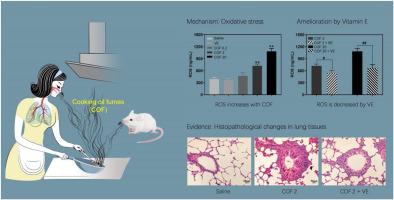Journal of Hazardous Materials ( IF 13.6 ) Pub Date : 2020-07-12 , DOI: 10.1016/j.jhazmat.2020.123455 Yongsheng Ma 1 , Linjing Deng 2 , Ping Ma 3 , Yang Wu 3 , Xu Yang 4 , Fang Xiao 1 , Qihong Deng 5

|
Background
As cooking is an essential part of people’s daily life, cooking oil fumes (COF) has been recognized as one of the major indoor air pollutant. Mounting epidemiological evidence has indicated that COF exposure is significantly associated with an increased risk of various health effects including lung cancer, but toxicological studies are very limited.
Objectives
We conduct a systematic study to provide toxicological evidence of COF exposure on the lungs, to examine the underlying toxicological mechanism, and to suggest intervention measures to mitigate this toxicity.
Methods
A total 96 female rats were randomly divided into control groups, COF exposure groups (0.2, 2, 20 mg/kg) and vitamin E protection groups, receiving appropriate treatment for 30 days. First we measured airway hyperresponsiveness (AHR) followed by a lung histological analysis to investigate the toxicological effects of COF. We next analyzed the biomarkers of oxidative stress, inflammation, and apoptosis to examine the underlying toxicological mechanism, and finally we investigated the protective effects of vitamin E against the toxicity of COF.
Results
AHR measurement indicated that the airway resistance increased with the COF dose and the lung histological assay showed narrowing of the airway lumen, which provided evidence of the toxicological effects of COF. The biomarkers of oxidative stress (ROS and MDA), pro-inflammation (TNF-α and IL-1β), and apoptosis (NF-κB and Caspase-3) were all significantly increased with COF dose. We observed that above toxicological effects and biomarker levels induced by COF were significantly ameliorated after administration of VE.
Conclusion
The toxicity of cooking oil fumes on the lungs is clear from the evidence and mechanism, and can be ameliorated by vitamin E. We suggested that oxidative stress may be primarily responsible for the observed cooking oil fumes-induced toxicity.
中文翻译:

烹调油烟的体内呼吸道毒理学:证据,机理和预防。
背景
由于烹饪是人们日常生活中必不可少的一部分,因此,食用油烟(COF)被公认为是主要的室内空气污染物之一。越来越多的流行病学证据表明,COF暴露与包括肺癌在内的各种健康影响的风险显着相关,但是毒理学研究非常有限。
目标
我们进行了系统的研究,以提供肺部COF暴露的毒理学证据,以检查潜在的毒理学机制,并提出减轻该毒性的干预措施。
方法
将总共96只雌性大鼠随机分为对照组,COF暴露组(0.2、2、20 mg / kg)和维生素E保护组,接受适当治疗30天。首先,我们测量气道高反应性(AHR),然后进行肺组织学分析,以研究COF的毒理作用。接下来,我们分析了氧化应激,炎症和细胞凋亡的生物标志物,以研究潜在的毒理学机制,最后我们研究了维生素E对COF毒性的保护作用。
结果
AHR测量表明,气道阻力随COF剂量的增加而增加,肺组织学分析显示气道腔变窄,这提供了COF毒理学作用的证据。氧化应激(ROS和MDA),促炎(TNF-α和IL-1β)和凋亡(NF-κB和Caspase-3)的生物标志物均随COF剂量显着增加。我们观察到,施用VE后,由COF诱导的上述毒理作用和生物标志物水平显着改善。
结论
从证据和机理来看,食用油烟对肺部的毒性是显而易见的,并且可以通过维生素E来改善。我们建议氧化应激可能是观察到的食用油烟诱导的毒性的主要原因。



























 京公网安备 11010802027423号
京公网安备 11010802027423号